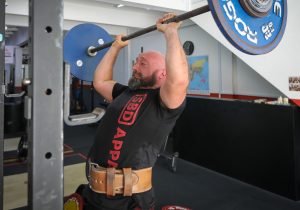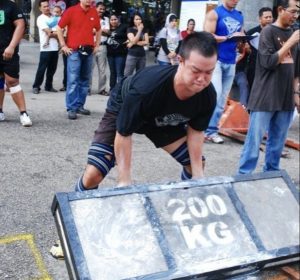Training isn’t meant to be comfortable – it never was, never is and never will be.
Even the greatest athletes of our time have stated the discomforts associated with their training. Mohammad Ali once said, “I hated every minute of training, but I said, ‘Don’t quit. Suffer now and live the rest of your life as a champion.’”
Admittedly, the vast majority of us aren’t athletes and will not reach anywhere near the feats that some of the greatest athletes have achieved. However, this doesn’t mean your training to achieve your goals, whatever they may be, will be easy.
Embrace Discomfort
“Do what feels good.”
“Lift what works best for you.”
“Use a comfortable weight.”
When browsing through the internet about strength training, you’re likely to come across the above advice fairly often. If you’re someone that understands the principles of training, you’ll know that this kind of advice isn’t useful nor is it particularly helpful.
As humans, we crave comfort – it requires little to no effort to stay in your comfort zone whereby it’s safe, warm and snuggly. Most people are unwilling to leave the safe confines of their comfort zones and understandably so – it’s hard, intimidating and unfamiliar. Unsurprisingly, a person that’s unwilling to move out of their comfort zone will apply the same mindset when it comes to barbell training.
Barbell strength training isn’t a comfortable endeavor – it’s about performing movements that are uncomfortable and pushing past your limits and what you think you’re capable of. It’s meant to be hard and it’s meant to challenge you. The weights feel heavy and that’s ok – it’s all part of the process.
Occasionally, clients would ask me “Shaun, can we stay at 60kgs till it feels easier before we increase the weight”? The answer, as you can guess, is no. The problem with staying at the same weight is that 60kgs will always feel hard if 60kgs is all that you’re capable of lifting. 60kgs will feel easy when you’re able to lift 100kgs. But if you want to be able to lift 100kgs, you must increase the stress that you’re currently already adapted to. Simply put, you must gradually increase the weight over time.
If you’re serious about your training and want to make progress, you must shed the mindset of ‘working within your comfort zone’ and start getting comfortable with being uncomfortable.
Understanding The Stress, Recovery, Adaptation Cycle
The stress, recovery, adaptation cycle is a simple process that’s the hallmark of all well thought out training programs.
The process starts off by stressing an organism above what it’s currently adapted to. You’re the organism and the stress applied are the barbell lifts that you do in the gym. For you to get stronger than where you are right now, the stress applied has to be more than what you’re currently adapted to. So if you as a system is currently adapted to squatting 60kgs for 3 sets of 5, you need to squat more than 60kgs for 3 sets of 5 to elicit a stress that’s sufficient to drive progress.
You can’t expect any progress from lifting the same amount of weights over and over again because you’re applying the same amount of stress at the level at which you are already adapted to. The only way to drive progress to increase the stress applied.
After the stress has been applied, your body will start a recovery response. If you provide the appropriate amount of time, rest and resources required to recover from that stress, the result of this process will be you accumulating some form of adaptation. This adaptation will be specific to the stress that was applied. In the case of you increasing the weight on the barbell for your squats from 60kgs to 62.5kgs, this process will result in you getting stronger.
Repeating this process over and over again, adding a little more weight to the bar each time, is how you get stronger. This means that to achieve your goal of enjoying the benefits of being a strong human being, you have to go through the uncomfortable process of constantly pushing past your limits.
After we’ve discussed the rationale behind the need to increase the stress applied and the inherent discomfort that it entails, there’s breaking down the optimal positions in the lifts themselves and why they are often uncomfortable. We discuss this in more detail in the next section.
Efficiency Over Comfort
Adding to the discomfort of constantly increasing your training stress, some of the barbell lifts require you to get into certain positions that just aren’t that comfortable to get into. Yet, they are necessary to perform a lift safely and efficiently.
New lifters almost always comment that the set up position of the deadlift feels incredibly awkward. Even after they get more accustomed to the movement, they still complain that it’s not the most comfortable position to assume.
This frequently leads to lifters setting up the deadlift with their hips lower than optimal because it feels less strenuous. However, this creates a problem. When the hips are lower than they should be, your shin angle will get more forward, which in turn pushes the bar forward, away from the body. The result? The bar ends up in a very inefficient position toward the forward end of the lifter’s foot
When deadlifting, have you ever experienced your shins being scraped by the barbell? If yes, it’s likely that your hips are lower than they should be. Ideally, you want the barbell directly over the lifter’s midfoot. This keeps the barbell over the lifter’s center of balance, which is the most efficient way to lift a barbell against gravity.
Can you lift the barbell in a less efficient but more comfortable method? Yes, of course you can but only when the weights are light. When the weights are light, you can lift them in any manner you please. However, when the weight gets heavy, which it will be eventually when you’re training, you’ll appreciate the benefits of being mechanically efficient.
Changing Your Mindset
Training toward a set goal will always be uncomfortable. Things worth having or that are valuable never come easy, no matter what is it. There is no way around it. Training in a way that is comfortable is a fallacy and is simply exercise, not training.
Exercise, or general physical activity, is performed based on how you feel the day of, with no long-term goal in mind. If you truly want to improve yourself or work toward a goal, you have to train. And when you train, there are going to be times where it’s going to be uncomfortable.
Instead of finding easy ways out and making training more comfortable, it’s more productive to direct your efforts toward changing your mindset to embracing the suck that comes along with bettering yourself.
Prepare yourself for the notion that training will be tough at times. You’ll have good days and you’ll have bad days. There’ll be tough days that tests your mettle and there’ll be days that the weights feel easy and manageable.
Discerning Between Discomfort and Pain
Discomfort and pain are 2 separate things – being able to discern the difference, acknowledge it and handle the situation accordingly are important. If you’re feeling pain and someone is telling you to keep pushing because ‘no pain, no gain, bro!’, stop listening to them and walk away. The discomfort of pushing against a heavy weight when you’re knackered is different from pushing through an injury.
About a decade ago, I was actively training for Strongman and competed regularly. On one particular competition, one of the events was the stone slab flip. Till this day, I can still remember the series of events very vividly. Stepping up to the start line, I mentally prepared myself and waited for the whistle to go off. The moment the whistle was blown, I gave it everything I had.
Three flips later, there was a very sharp pull on the lower portion of my left hamstring and I immediately dropped to the floor. It felt as though someone had stabbed my hamstring with a hot knife. Did I know that it was an injury? Yes. Should I have stopped competing there and then? Yes. However, being young and stupid, I wanted to carry on with the rest of the events and complete the whole competition. Copious amounts of Deep Heat was applied to the affected area, coupled with some painkillers and I was ready to get back into competing.
The mixture of adrenalin, Deep Heat and painkillers kept me going despite the pain and I finished 6th that day. The moment the competition was over, the pain reintroduced itself with a vengeance. Later that night while I was sitting in my bed trying to apply some Deep Heat to my hamstring, I noticed that there was bruising over the injured spot – a sign of a torn muscle belly.
The next week or two wasn’t fun – every single time I moved my leg, the pain reminded me of my stupidity. Slowly but surely, with proper rehab, it got better and was back to being fully functional within the month. On hindsight, the decision to carry on competing wasn’t the wisest but it taught me a valuable lesson.
When you first start training, everything feels hard and “painful”. After you’ve accumulation enough hours under the barbell, you’ll be able to discern what’s discomfort that you can and should push through or an injury that’s telling you to stop.
If you’ve been shortchanging yourself and constantly finding excuses when training gets tough, I encourage you to embrace the discomfort that’s par for the course. When you’re in that moment of pushing against a heavy weight, when every fibre in your body is telling you to stop and you keep pushing anyways, you’ll learn many things about yourself and what you can achieve if you dig deep and fight for it.




